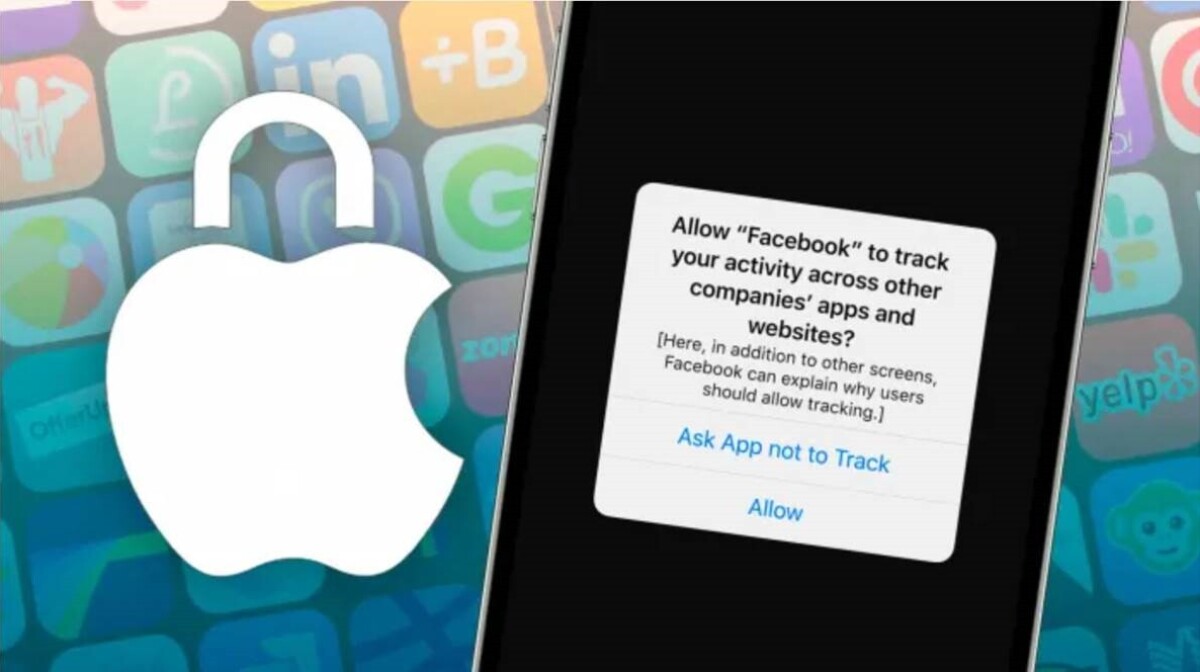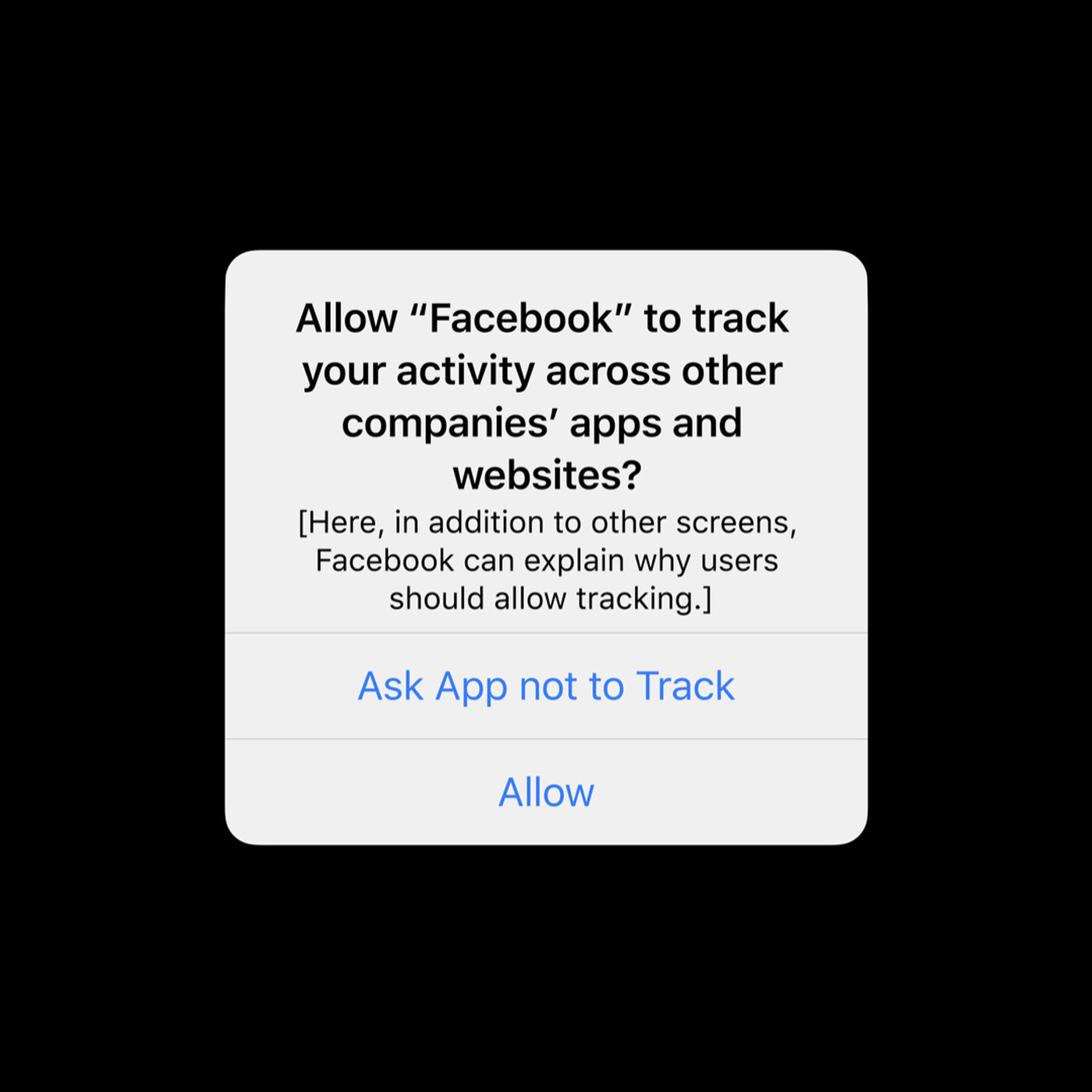
Apple’s iOS 14.5 update began its rollout in late April. As part of the update, Apple is giving users the choice to block the Identifier for Advertisers (IDFA) at the app level instead of the device level. Among other changes, this means that the iOS 14.5 update will require apps to ask users for permission to collect and share data, including the data used to target users and track the effectiveness of digital advertising.
For advertisers, the results of this change will vary based on the type of targeting used, type of advertising used, and the length of the conversion funnel. Though in general, digital ads will result in fewer reported conversions, with impression-dependent ad vehicles like display and Facebook being affected more than click-dependent ad vehicles like paid search.
After users install the iOS 14.5 update, they will see a privacy notice like this when they open apps:

Currently, about 70% of iOS users share their IDFA with app publishers. After the update, it is expected that the number will drop to below 25%-30%.
Advertisers Will Be Impacted in Three Main Areas
Audience Targeting
Advertisers’ ability to target ads to iOS 14.5 users who have opted out of tracking will be limited.
- Pixel-based audiences will be impacted the most (retargeting, add to cart, cart abandonment, some conversions).
- The scale of certain tactic audiences will be dependent on opt-out rates.
- It’s important to remember that this only applies to iOS devices. Most people use 5-7 devices on a regular basis, so advertisers will be able to target them on other devices, such as desktop, so long as advertisers are using an audience provider (like BlueKai) that targets individuals across all their devices.
Ad Retargeting
Any device-level retargeting to users will no longer work for users that have opted out of sharing their IDFA. Platforms like Google and Facebook have other deterministic variables they can use to identify devices (email, phone number) but other programmatic platforms that don’t have such deterministic ID graph information are likely to see a reduction in targetable audiences.
Ad Measurement
Though Apple’s new SKAdNetwork (an Apple-controlled tracking system for apps) will allow for conversion data to be passed back at the campaign level, advertisers will still see a reduction in the data they can use to identify performance on iOS devices.
- Importantly, this change will not affect the tracking of conversions that happen during the session created by a click on an ad that lands the user to a website/app. Instead, this will affect the ability of ad engines (and website/app engines) to tie conversions back to clicks/sessions that happened prior to the current session.
Facebook will only allow advertisers to track one conversion type, which is prioritized and chosen by the advertiser, for opted-out users. For opted-in users, up to eight conversion types can be tracked.
Facebook is proactively applying these changes to all Facebook advertising, instead of limiting them to ads shown to iOS 14.5 devices that have opted out of tracking.
Reporting
- Website conversion events will be reported based on when the conversion occurs instead of the current practice of reporting based on when the impression occurred.
- For advertisers with longer sales cycles, this will require advertisers to work harder to understand the effectiveness of any short-duration initiatives.
- Additionally, there may be a 24–48-hour delay when an off-platform Facebook conversion is reported from iOS users.
- Facebook will no longer be able to support 28-day click-through / 28-day view-through, shifting to 7-day post-click / 1-day post-view for Reporting.
- Delivery and action breakdowns will not be supported for any conversion events that happen outside of Facebook’s platform.
- If a user is sent from an ad click to your website, Facebook will not provide demographic breakdowns (age, gender, region) for any conversions that take place on your site. This will make it more difficult for advertisers to develop and act on demographic insights.
The tracking changes will have the biggest effect on advertisers who rely heavily on Facebook/Instagram impressions to feed the conversion funnel, as Facebook’s algorithm will no longer account for view-through conversions when making bidding decisions.
What to Expect and When
Immediate
- The Facebook reporting changes outlined above (look back windows, conversion events reported when conversion occurs, & not the impression, etc.) are already in effect.
- Facebook will limit the number of conversions a specific campaign is able to track.
Gradual
- Expect users to update their apps/devices slowly over several weeks.
- There may not be an immediate effect on audience size.
Recommendations
Targeting
- Prepare to become less reliant on pixel-based audiences (retargeting, retargeting LA, cart abandonment, etc.) as audience pools shrink.
- Increase reliance on first-party data for audience modeling.
- Re-evaluate contextual & PMP targeting solutions in order to target opted-out users who have become more challenging to reach through pixel-based tactics.
Reporting
- Be prepared to see an inevitable decrease in reported conversion & revenue volume.
- Reset expectations regarding campaign success metrics.


